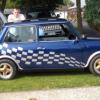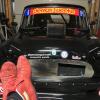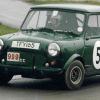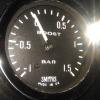
Bhp Or Torque?
#1

Posted 28 July 2018 - 09:44 AM
The reason I ask is having recently built a 1132 for one of my minis which made 61ft/lb but only 43bhp mainly down to the std HS2 inlet and tiny exhaust bore dia. I’ve become slightly obsessed with improving the BHP as it’s way down on the expected figure. BUT the car pulls really well hence is the disappointment of BHP really that important?
Is there a proportionate link between the BHP and Ft/lb?
If I get the BHP up (easily achieved with a ‘stage one kit’) but not too original looking on a early mk1, what will happen to the Torque?
Just my curious mind ticking...
#2

Posted 28 July 2018 - 10:21 AM
#3

Posted 28 July 2018 - 10:26 AM
Torque is more important. BHP is only a mathematical calculation of torque by RPM
#4

Posted 28 July 2018 - 12:26 PM
Torque is force, Bhp is power (amount of work done).
To us as tuners improving torque is easier to see benefits. Moving a car over a distance involves more work the quicker you do it. The energy expended comes from burning petrol that requires burning at the right ratio with the air in the cylinders for maximum efficiency and to stop bits of the engine burning, or melting, instead. So power largely comes down to how much air you can put through an engine in a given time. There are 2 ways of doing that: have more air in the cylinders for each power stroke or spin the engine faster so you fill the cylinders more times per minute or mile.
The first option, more air per filling, can be achieved by removing restrictions to the airflow; altering the valve opening, rate, lift or period; forcing air in (supercharging); just having bigger cylinders. The second, spin it faster, option won't be effective on its own if you also need to do some of the first option stuff to keep filling the cylinders as full as the amount of time to do it in reduces proportional to increased rpm. Even if you get it right you'd need to alter the gearing to allow more revs for distance travelled, or the extra power would only be available if you tried to do higher speeds. "Tried" is correct because higher speed will require exponentially more power than just spinning the same engine faster will achieve.
Conveniently, better breathing, bigger bores and blowers increase torque as well as the potential to make more power, so the effect can be felt just by pressing the accelerator pedal without changing gear or waiting for the revs to build. Cams can do a bit of both, but as a rule the more power they give the more revs they need to do it, often at the expense of power at lower revs (torque).
#5

Posted 28 July 2018 - 02:01 PM
At what point does the BHP become more important than ft/lb? Torque accelerates a car right? So is BHP relevant for anything other than too end speed.
The reason I ask is having recently built a 1132 for one of my minis which made 61ft/lb but only 43bhp mainly down to the std HS2 inlet and tiny exhaust bore dia. I’ve become slightly obsessed with improving the BHP as it’s way down on the expected figure. BUT the car pulls really well hence is the disappointment of BHP really that important?
Is there a proportionate link between the BHP and Ft/lb?
If I get the BHP up (easily achieved with a ‘stage one kit’) but not too original looking on a early mk1, what will happen to the Torque?
Just my curious mind ticking...
Respectfully, and I see this loads of time, it's an 'easy trap' to fall in to.
Don't look too much at the peak numbers, they are almost meaningless and really best reserved for a Pub shooting match.
Have a look at the total curves of ft/lb and HP from 1500 RPM up to Red Line.
Generally speaking, small motors can be more peaky, or put another way a steep power rise higher in the RPM range than bigger engines, so while they may make similar numbers, just how they get there is often poles apart.
Also, when looking at 'the number' is often at engine speeds of 5000 or 6000 RPM. You need to get from 1200 RPM up to these high numbers first!
So, don't look at these 'peak numbers', look at how it gets to that peak as 99% of the time, that is what you are driving on and pulling out of corners with etc.
#6

Posted 28 July 2018 - 05:19 PM
#7

Posted 28 July 2018 - 06:33 PM
Thanks for the replies so far. I guess what I’m trying to figure out is if it’s worth me chasing a gain say of 15 Bhp, when the torque may not increase thus not really improving the acceleration. The mini currently reaches 70mph with ease and pulls up the hills well so chasing a higher bhp figure may prove pointless. Retro man is looking at flow differences between std spec and a Vizard spec HS2 and cast inlet so maybe this will be worth exploring over winter. At least that way the car remains std looking. Currently peak torque is 2800rpm and remains pretty much flat between 0-3250. The peak bhp is achieved at 4500rpm. The engine is running a MG1100 2 ring cam.
torque has to increase to gain any more BHP. increasing torque is what you should be looking at.
#8

Posted 28 July 2018 - 06:57 PM
At what point does the BHP become more important than ft/lb? Torque accelerates a car right? So is BHP relevant for anything other than too end speed.
The reason I ask is having recently built a 1132 for one of my minis which made 61ft/lb but only 43bhp mainly down to the std HS2 inlet and tiny exhaust bore dia. I’ve become slightly obsessed with improving the BHP as it’s way down on the expected figure. BUT the car pulls really well hence is the disappointment of BHP really that important?
Is there a proportionate link between the BHP and Ft/lb?
If I get the BHP up (easily achieved with a ‘stage one kit’) but not too original looking on a early mk1, what will happen to the Torque?
Just my curious mind ticking...
Minigman - what specification are you using for the cylinder head, and has the camshaft been changed?
61ftlb is pretty respectable torque for 1132cc. You don't mention the rpm at max power, but i would guess the torque will have dropped back to 43ftlb by about 5250rpm (bhp=ftlb at this rpm).
#9

Posted 28 July 2018 - 07:09 PM
Max bhp was achieved at 4250rpm and cam is a AEA630.
It does say above on my 2nd post.
#10

Posted 28 July 2018 - 08:52 PM
Thanks for the replies so far. I guess what I’m trying to figure out is if it’s worth me chasing a gain say of 15 Bhp, when the torque may not increase thus not really improving the acceleration. The mini currently reaches 70mph with ease and pulls up the hills well so chasing a higher bhp figure may prove pointless. Retro man is looking at flow differences between std spec and a Vizard spec HS2 and cast inlet so maybe this will be worth exploring over winter. At least that way the car remains std looking. Currently peak torque is 2800rpm and remains pretty much flat between 0-3250. The peak bhp is achieved at 4500rpm. The engine is running a MG1100 2 ring cam.
Had the standard HS2 and HS4 manifolds CFM measured by Turbo Phil and will be modifying them before re-testing.
Will do the same with carbs.
Just vizarded an HS2 and manifold for a 750MC guy they run the reliant 850 he gained over 20% torque...!!
He won his first two races at Penbury...which was astounding, he got a good mention and a photo in Autosport
#11

Posted 28 July 2018 - 09:12 PM
I would love to know the results when you have them. I’m sure many other mk1 owners will be interested in modified standard looking parts for the sake of originality,if it improves the overall performance.
#12

Posted 28 July 2018 - 10:46 PM
My thoughts re modified carbs are that every engine is an air pump, so anything that improves the flow should improve the output
You don't need to go bigger to improve the flow, air will flow round a sharp 15 degree corner without loss...but
all air has to 'negotiate' the 2 main edges in all Su carbs...both are 90 degrees, one sharp and one very sharp
then there are casting flaws / flash / screw holes / breather holes and a gatepost of a spindle with screws tails
The smaller the carb the worse the effects.
I am compiling 2 spread sheets on various SU sizes etc and another on flows, standard and modified
Turbo Phil is measuring the flow figures which is a great help (Thanks Phil)
I think a vizarded HS2 and manifold will flow more than a standard HS4 setup
and will have better gas speeds which should give more torque, which is what we all want.
The spread sheet figures will be useful for all A series and SU users, they should work as a reference
we should all be able to learn from them, answer some questions and dispel some myths
#13

Posted 28 July 2018 - 10:54 PM
above is one very important phrase.
"gas speeds"
i would like to add "big is not best".
#14

Posted 29 July 2018 - 10:53 AM
#15

Posted 29 July 2018 - 11:34 AM
Gas speed should, and probably will, mean more inertia to ram air into the cylinder and obstruct it coming back out.
It could also mean more fuel is thrown out as the charge negotiates the bends in the inlet and altering a carbs airflow could also alter how it meters fuel. I only mention it in case someone reads this and thinks they can gas flow a carb and just bolt it back on to see instant improvements.
1 user(s) are reading this topic
0 members, 1 guests, 0 anonymous users


















